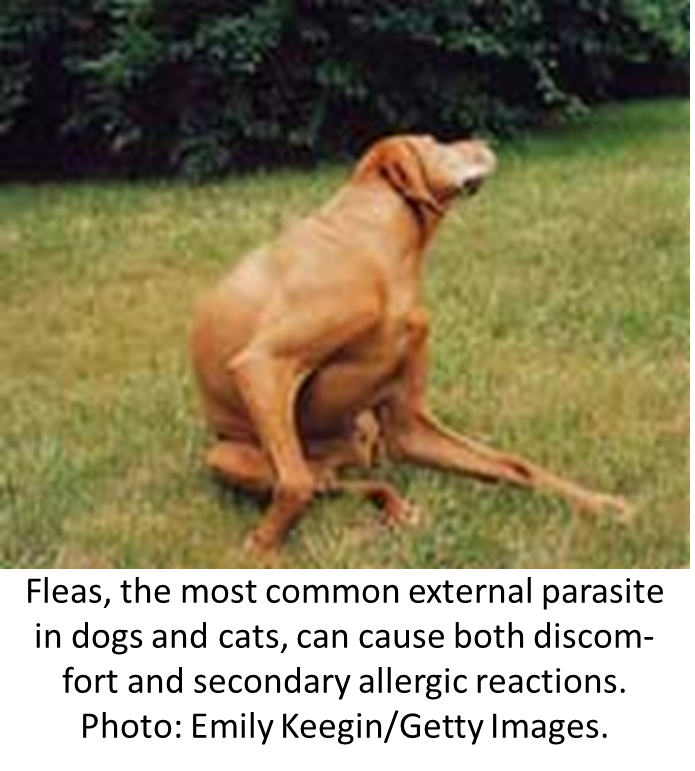Parasite Control in Pets Requires Year-Round Vigilance
Pets presented for complaints associated with some pathology of their skin — such as pruritis, abnormalities of keratinization, alopecia and other abnormalities both primary and secondary— comprise a large percentage of cases seen by veterinarians.
Not surprisingly, parasites are responsible for a great many of these cases, some directly associated with an inflammatory process following the bite of an external parasite.
Few would argue that fleas are the most common external parasite in dogs and cats. They are virtually universal in their distribution and have voracious appetites for blood. They feed frequently, necessitating multiple bites that at very least result in a focal discomfort and commonly produce secondary allergic reactions that can be amazingly severe.

Flea-bite dermatitis and flea-allergy dermatitis can incite secondary problems, such as papular and pustular rashes, self excoriation and seborrhea as a response to the inflammation. It can be difficult to determine if flea-associated dermatopathies are primary skin diseases or secondary complicating factors

Often considered seasonal parasites, fleas are amazingly hardy pests that in their immature stages can survive the most challenging conditions. They also have an amazing ability to infest locations where the environment is more hospitable, such as places where animals are housed, areas protected from cold (crawl spaces and under porches), upholstered furniture in homes and even interiors of automobiles.
In short, fleas are everywhere and must be controlled the year around. Fleas always should be considered in virtually any skin-associated presentation of a pet, and pet owners must be reminded to always take a preventive approach.
Ticks, too, can play a role in skin diseases. Though not as ubiquitous as fleas, they can survive inhospitable conditions in sheltered areas. They may play a smaller role in inciting generalized dermatitis, but the site of their attachment frequently results in a localized reaction.
In the past, fleas and ticks were the bane of veterinarians. Available products were difficult to use, unpleasant and potentially toxic. They required frequent application and often necessitated environmental treatments, such as household and kennel applications. Those products left much to be desired.
Today, flea and tick products are far more effective, including systemic compounds, administered orally, that disseminate insecticide via the bloodstream, topically applied products that are spread over the skin from single sites of application and growth-hormone regulators that interrupt the life cycle of fleas. All are effective, safe and economical.
It is far easier to prevent infestations and the skin diseases they cause. The best way to do so is through regular, year-round pre-emptive use of a product for all dogs and cats in a household.
Lice and mites
Lice and mites can result in significant inflammatory responses and can at times be difficult to diagnose. Demodectic mange, scabies, Chyletiella mites and infestations with lice always should be considered and ruled out as initiating or complicating factors in skin presentations.
Treatments can be challenging and frequently involve treating all pets in the household as well. For treatment protocols, go to http://www.capcvet.org .The role these external parasites play in skin-related presentations is relatively obvious; in fact, their presence often is sufficient evidence that they are causing disease.
But that is not always the case. The health of the skin is truly a reflection of overall health and the presence of internal parasites, particularly if an individual is heavily parasitized or particularly vulnerable the effects of parasites, as is the case in young animals, aged animals or those on a poor plane of nutrition or debilitated by systemic disease.
Internal Parasites
The presence of tapeworm segments in feces or on the perineum can be important. While they generally are benign parasites, tapeworms indicate the patient likely has a flea infestation of some degree, unless there is a potential that the patient has been consuming rats.
Roundworms and hookworms in particular can result in anemia and poor absorption of essential nutrients for a variety of reasons, from increased motility to inflammatory bowel syndromes.
A part of the workup of any patient with significant skin disease should include at least one fecal flotation by centrifugation to confirm the presence or absence of parasites that might complicate the diagnosis.
Even if a patient is on a monthly product to prevent and control heartworms and internal parasites as recommended by the Companion Animal Parasite Council (CAPC), a properly performed fecal examination is important. We know that compliance by owners is not what it should be. Additionally, not all internal worms are prevented by available products.
It is clear that no organ system exists in a bubble, free of the influence of another. For that reason it is important to rule out parasites as an inciting or contributing factor in all disease presentations, including dermatology cases.
CAPC guidelines call for monthly year-round use of an external parasite product to control fleas and ticks as well as the monthly year-round administration of a broad-spectrum product to control internal parasites and prevent heartworms. These products should be used in all animals in all parts of the country the year around.
Dr. Paul is past Executive Director and CEO of the Companion Animal Parasite Council. He is a former president of American Animal Hospital Association, and has been part of the National Commission on Veterinary Economic Issues.
Originally printed in DVM/InFocus, May, 2008, and used by permission.
